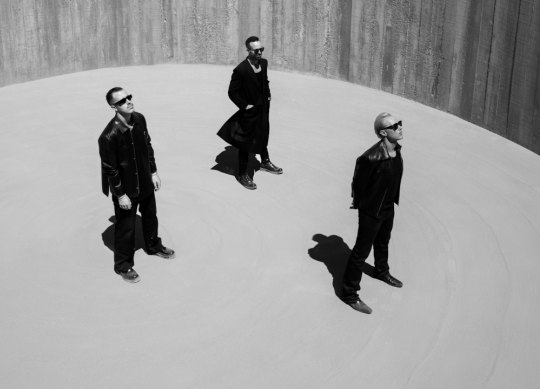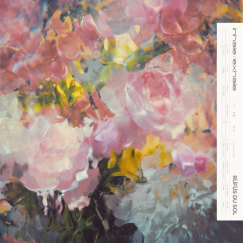By Annabel Ross and Barry Divola
Soccer Mommy, Evergreen
Anyone who has lost a parent will tell you about the shock, even if it’s been coming for a while and is not totally unexpected. Then the flood of emotions washes in and the ticker-tape of memories rushes through your head – the thoughts of things said and things left unsaid, the regrets, the tears, the jokes, the laughs, and, hopefully, after the initial grey wave of grief crashes through you and recedes, the gratitude for this person who brought you into the world and has now departed the world.
For Sophie Allison, who makes music under the name Soccer Mommy, it’s complicated. Because she’s been preparing for her mother’s death since she was 12, when she was diagnosed with cancer.

Sophie Allison, aka Soccer Mommy, tackles grief and loss on her fourth album.Credit: Anna Pollack
The 27-year-old from Nashville has written about her mother before, while she was still alive, most notably on Yellow is the Color of Her Eyes, a majestic seven-minute slow-burner from her 2020 album Color Theory. “Loving you isn’t enough,” she sang. “You’ll still be deep in the ground when it’s done/ I’ll know the day when it comes/ I’ll feel the cold as they put out my sun.”
Since writing that song, Allison’s sun has indeed gone out, and you can hear how that feels on the fourth Soccer Mommy album, Evergreen.
Allison has never been backward in coming forward about her emotions. As far back as her 2018 debut album, Clean, on lead single Your Dog, she let a guy know in no uncertain terms what she did and didn’t want: “I’m not a prop for you to use when you’re lonely or confused/ I want a love that lets me breathe, I’ve been choking on your leash.”
She arrived on the scene in a musical Venn diagram where Liz Phair and Juliana Hatfield overlapped – deeply confessional songwriting delivered via indie rock songs with Doc Martens firmly planted in the 1990s. Unsurprisingly, Phair’s name came up constantly in reviews and stories about Soccer Mommy, as Allison seemed to be an inheritor of her mantle. But in early interviews, she unashamedly espoused her love of Avril Lavigne and Natalie Imbruglia and talked about a desire to have a top 40 hit.
For those old enough to remember ’90s magazine Sassy, she seemed like a late-blooming product of that publication, which influenced a whole generation of US teenage girls, mixing the anger and energy of riot grrrl with a love for mainstream pop culture and an Aubrey Plaza-like sense of being in on a joke that others don’t get.
We get older. We change. Our parents get older. Our parents die. And here we are with Evergreen.
Allison has chosen to strip back the sonic accoutrements she’s built around her indie-rock template over the last couple of albums. Opening track Lost couldn’t get much more direct, sonically or lyrically. Over acoustic guitar and keening strings, she states it plain and simple: “Lost in a way that don’t make sense/ Lost in a way that never ends.”

Soccer Mommy’s Evergreen: achingly personal songs about her mother’s death.
M is a country-rock canter augmented by flutes and strings, with Allison talking to hollow walls and empty halls, hearing her mother’s voice in all her favourite songs; while Changes, the first song she wrote for the record, finds her in her mother’s house, now newly painted, worrying that “every time I call here, I’m further away/ slipping through my fingers, I can feel the changes/ I don’t want to face it.”
But Evergreen isn’t just a concept album about grief. Salt in Wound is a gangly alt-rock creeper from the Phair/Hatfield school; Anchor has a herky-jerky feel that makes it an outlier; and Abigail is about a character in the role-playing game Stardew Valley, something that sounds intriguing on paper even if it sounds like a slightly slowed-down version of The Cure’s Inbetween Days.
Set against the achingly personal songs about her mother, these tracks are serviceable but can feel a little like side-trips. That feeling is magnified when we get to the closing title track, a gorgeous and devastating thing where Allison sings “she cannot fade, she is so evergreen” while the strings gently weep. It’s a fitting end to the record, and a fitting testament to the woman she has lost. Barry Divola
Rufus Du Sol, Inhale/Exhale
There was a moment at Burning Man (I know) in 2022 where it seemed like the entire festival was looking for Rufus Du Sol. The Sydney-born band have been based in the US for years now, and a rumour that the electronic trio was going to play a set on the playa had tens of thousands of “burners” in a tizzy.
I could understand the desire to hear the band play Innerbloom, from their 2016 sophomore album Bloom. A Burning Man-at-sunrise anthem if ever there was one, it’s a nearly 10-minute long track that enthrals for the duration thanks to a deliciously slow build, narcotic chord progressions, and a hypnotic metronome providing the most compelling backdrop yet for Tyrone Lindqvist’s bruised vocal.

Rufus Du Sol: The Grammy-winning Sydney trio include Tyrone Lindqvist, Jon George and James Hunt.Credit: Boaz Kroon
Rufus have made a few decent tracks since, but while nothing comes close to Innerbloom, their fandom expands with every record in spite of, or perhaps due to, their narrowing sonic template. On their latest LP, Inhale/Exhale, they throw a new hubcap on the same wheel that’s been greased very effectively for the past two albums.
The band has always peddled in atmospheric electronica, but on their 2014 debut, Atlas, a few tracks seemed to be aimed for sunny afternoon festival sets. In the intervening years, as Rufus began to attract audiences in their tens of thousands at arenas and festivals including Coachella and Bonnaroo, the boys settled on a sound better suited to late-night headliners. Even as their lyrics speak of platitudinal love, hope and light, the production is determinedly dark and moody, matching their increasingly haute, austere aesthetic, the kind wielded by artists making serious money.

Inhale/Exhale, their fifth album, is overwhelmingly slick and familiar.
Inhale/Exhale is highly polished, carefully sequenced, stadium-sized dance music that’s sure to resonate loudly with Rufus’ fans, who seem to appreciate the band’s consistency. The chilly synths, droning, rubbery bass notes and generic lyrical touchpoints — earth, wind, water, fire, dancing, desire, joy, pain — are all there. Shifts in dynamics, while subtle, map out a journey across the album’s 15 tracks, opening with Inhale and closing with you-know-what.
The first three tracks (imperious, brooding) bleed into each other so seamlessly it’s hard to tell where one ends and another begins, and this feels by design; I wouldn’t be surprised if the album is performed in sequence at their gigs. Transition track Music is Better is one of the cringier cuts in the Rufus catalogue. The most basic and sappy of lyrics can still hit if the production and vocals are glorious enough (see Stardust’s Music Sounds Better With You), but Lindqvist’s monotone, nasally drawl conveys drudgery rather than elation, and the bouncy synths and pow-pow laser effects sound juvenile and generic.
A fan favourite on 2021’s Surrender was On My Knees, and Pressure, similarly distinguished by synths mimicking huge rock guitar chords, feels destined to have the same effect on audiences, especially at Rufus’ increasingly grandiose live shows.
New York, at the album’s midway mark, provides needed, semi-beatless relief, allowing Lindqvist’s heartsick vocals to float over the top of the mix. But overall, there are too few curiosities on an album that sounds overwhelmingly slick and familiar.
The trio comprising Rufus are nice lads, as far as I can tell, and I don’t begrudge them their fame and fortune. Far more interesting than Rufus’ well-honed but formulaic output, however, is another lesser-known Melbourne act on their Rose Avenue record label called Adult Art Club, who are weirder, braver, and more varied. The “if it ain’t broke” approach seems to be working just fine for Rufus, but where there are no risks there are no thrills. Annabel Ross
Sophie, Sophie
British producer Sophie was one of the most influential figures of ’10s pop. She gained a cult following in 2014 with the releases of Bipp and Lemonade – futuristic tracks beamed in from a faraway galaxy, threaded with sounds and textures at once cold and colourful, alien and beguiling. Her ceaseless innovation would eventually have swaths of the pop landscape either imitating her or hitting her up to collaborate. Sophie worked with the likes of Rihanna, Madonna, Vince Staples and Charli XCX; XCX dedicated a song to the producer on her recent world-beating (and thoroughly Sophie-inspired) album Brat.
After years as a recluse Sophie emerged as a glamorous trans woman and instant queer icon in the music video for It’s Okay to Cry, from her stunning 2017 debut solo album Oil of Every Pearl’s Un-Insides. Her music made more sense than ever, its transgression the clear expression of someone whose art and identity would never fit into rigid binaries.

Sophie, who died in Athens in January 2021.Credit:
In Athens in January 2021 Sophie slipped and fell to her death while climbing a balcony to get a better view of the full moon. Her brother and studio manager Benny Long doubtless felt immense pressure to honour her legacy on this eponymous posthumous album. His effort is palpable across the 16-track LP of collaborations, but so is Sophie’s absence on the final cut.
The structure of the record is fairly conventional. The first few tracks conjure black holes in deep space with oppressive, droning sounds lending a funereal quality. By the time Reason Why, featuring Kim Petras and BC Kingdom, arrives in a sheeny spurt of mid-tempo, mid-energy hyperpop, it feels like opening the blinds after days of mourning.
The song kicks off a cartoony, playful run of tracks before the record veers into techno territory that’s darker but not aggressively so. Synths pop like artificial gunfire in a video game and, while percussion patterns are militant, the snares are muted, as though the drumstick tips have been coated in cotton wool. Berlin Nightmare and Gallop, featuring Sophie’s former partner Evita Manji, are more anxious and foreboding, the sort of thing that could soundtrack a tense heist in a discerningly scored Payday 2 series.

Sophie’s brother and studio manager Benny Long oversaw this 16-track LP of collaborations.Credit:
Exhilarate kicks off the sentimental send-off stretch of the album. It features Bibi Bourelly, who co-wrote Bitch Better Have My Money and whose voice approximates Rihanna’s on an empowerment anthem treated with enough Sophie-esque flourishes – atonal bass blobs, a faint, ever-present buzz – to render it refreshingly weird.
Always and Forever is pastel-toned and gauzy, with Hannah Diamond’s helium coo sending the tribute heavenwards. The yearning, ’80s-indebted production on My Forever is more emotive and, combined with longtime colleague Cecile Believe’s plaintive, clear vocal turn, makes for the record’s most memorable track after Reason Why.
Sophie had already chosen the full track list, and most songs were close to completion, according to Long. He says finishing the album was a matter of “honing” certain sounds he knew Sophie wasn’t happy with, but we’ll never know how it might have sounded if Sophie had been the one doing the honing. Sophie is a painstaking labour of love, but it also feels like a diluted distillation of her essence. You can’t help but suspect that Sophie’s version would have far eclipsed its impact. Annabel Ross
Find out the next TV, streaming series and movies to add to your must-sees. Get The Watchlist delivered every Thursday.